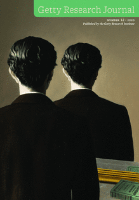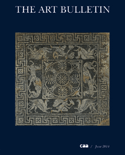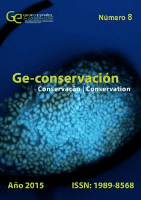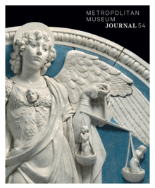
Getty Research Journal
Scope & Guideline
Bridging the Gap Between Art and Academia
Introduction
Aims and Scopes
- Interdisciplinary Art Historical Research:
The journal focuses on art history as an interdisciplinary field, examining visual culture through various lenses such as sociology, anthropology, and cultural studies. - Innovative Methodologies in Art Analysis:
It emphasizes the use of innovative methodologies, including digital tools and computational analysis, to enhance the study of art and artifacts. - Cultural Contextualization of Artworks:
Research often contextualizes artworks within broader social, political, and historical frameworks, providing a deeper understanding of their significance. - Exploration of Global Art Practices:
The journal covers global art practices, emphasizing the importance of non-Western perspectives and transnational dialogues in art history. - Focus on Conservation and Preservation:
There is a consistent focus on conservation practices and the ethical implications of preserving cultural heritage.
Trending and Emerging
- Digital Humanities in Art Research:
There is a growing emphasis on digital humanities, utilizing technology to analyze and visualize artworks and historical documents, which enhances accessibility and research capabilities. - Intersectionality in Art and Gender Studies:
Recent publications increasingly explore intersectional approaches to art, examining how gender, race, and class intersect within artistic practices and representations. - Environmental and Ecological Art Histories:
Emerging themes relate to environmental concerns and the representation of nature in art, reflecting a broader cultural shift towards ecological awareness. - Art and Memory Studies:
There is a rising interest in how art serves as a medium for memory and commemoration, particularly in the context of conflict, trauma, and cultural heritage. - The Role of Art in Social Movements:
Scholarship is increasingly focusing on the role of art in activism and social movements, exploring how visual culture influences and reflects societal changes.
Declining or Waning
- Traditional Biographical Studies of Artists:
There has been a noticeable decline in traditional biographical studies that focus solely on the lives of individual artists, as the field increasingly moves toward broader contextual analyses. - Static Interpretations of Artworks:
Static interpretations that do not consider the dynamic cultural and historical contexts surrounding artworks are becoming less common, as scholars seek to engage with more fluid and multifaceted analyses. - Eurocentric Perspectives:
Research that focuses predominantly on Western art and artists is waning, reflecting a growing emphasis on global and diverse art histories. - Conventional Exhibition Reviews:
Reviews of exhibitions that lack critical engagement or innovative insights are appearing less frequently, as the journal aims to maintain rigorous scholarly standards. - Historical Artifact Cataloging:
While still important, the focus on merely cataloging historical artifacts without deeper interpretative work is declining in favor of more analytical approaches.
Similar Journals

ART BULLETIN
Illuminating Insights in the World of Visual ArtsART BULLETIN is a prestigious journal dedicated to the fields of history and visual arts, published by Routledge Journals, Taylor & Francis Ltd. With a rich publication history dating back to 1945, this journal serves as a vital platform for scholarly discourse, presenting cutting-edge research and critical analyses that contribute to our understanding of the arts across various contexts. Despite its Q3 ranking in both the History and Visual Arts categories, the journal has managed to achieve notable stature among its peers, evidenced by its Scopus ranking, placing it in the top 20% for Visual Arts and in the top 25% for History. Scholars and students alike will find valuable insights and innovative perspectives within its pages, making it an essential resource for anyone invested in the academic exploration of art and cultural history. Although currently not open access, the journal is committed to fostering an informed community by disseminating works that encourage scholarly engagement and creative thought.

Umeni-Art
Exploring the Intersection of Art and ScholarshipUmeni-Art is a prominent journal in the field of visual arts and performing arts, published by the Institute of Art History, Academy of Sciences, Czech Republic. With its ISSN 0049-5123 and E-ISSN 1804-6509, the journal has established itself as a critical platform for scholarly discourse and artistic expression since its inception in 2002. Although currently classified in Q4 within the Arts and Humanities category, it aims to elevate the understanding and appreciation of the arts through rigorous research and innovative perspectives. The journal's Scopus ranking places it at Rank #573/667, reflecting its growing contribution to the field and expanding reach within the artistic community. With a focus on fostering collaboration among researchers, practitioners, and students, Umeni-Art seeks to enrich the academic landscape with significant findings and discussions that inspire future research and creative endeavors. While it does not offer open access, the journal remains a valuable resource for those vested in exploring the dynamic interplay between art, culture, and society in the contemporary context.

Visual Studies
Transforming perspectives through critical visual scholarship.Visual Studies, published by Taylor & Francis Ltd, is a leading international journal that serves as a vital platform for interdisciplinary scholarship in the fields of visual arts, cultural studies, and anthropology. Established in 2002 and continuing strong through 2024, it holds impressive rankings including Q1 in Cultural Studies and Visual Arts and Performing Arts, as well as Q2 in Anthropology, reflecting its significant impact and prestige within these disciplines. With a robust Scopus ranking placing it in the 89th percentile for Visual Arts and Performing Arts, this journal does not only publish original research but also fosters rich dialogues on visual culture, representation, and critical theory. Although it is not open access, researchers, practitioners, and students alike can benefit from its rigorous peer-reviewed content, which contributes to advancing knowledge and understanding of visual phenomena. Located in the United Kingdom, Visual Studies continues to shape the conversations surrounding visual practices and their societal implications.

Ge-Conservacion
Innovating Practices for the Preservation of Art and HistoryGe-Conservacion, published by GRUPO ESPANOL I I C, stands as a pivotal journal in the fields of Conservation, Museology, and Visual Arts and Performing Arts, facilitating an open-access platform since 2009. Based in Spain, this journal serves as a vital repository for innovative research and scholarly dialogue, significantly impacting the community with its Q1 and Q2 rankings across several categories in 2023. With an objective to advance multidisciplinary understanding and practices related to cultural heritage conservation, it attracts a diverse readership of researchers, professionals, and students eager to engage with contemporary issues and methodologies. The journal's commitment to accessibility enhances its reach and influence, making it an essential resource for anyone passionate about preserving the integrity and significance of our artistic and historical treasures.

Vestnik Sankt-Peterburgskogo Universiteta-Iskusstvovedenie
Advancing Scholarship in Music, Visual Arts, and HistoryVestnik Sankt-Peterburgskogo Universiteta-Iskusstvovedenie, published by ST PETERSBURG UNIV PRESS, is a distinguished academic journal based in the Russian Federation, focusing on the interconnected disciplines of Conservation, History, Music, and Visual Arts and Performing Arts. With an ISSN of 2221-3007 and E-ISSN of 2542-2243, this journal plays a vital role in disseminating scholarly research and fostering dialogue across these fields. Despite being categorized in the third quartile (Q3) in 2023 across its respective disciplines, its significance lies in publishing emerging research and critical analyses that contribute to the academic discourse. The journal accepts submissions until the converged years spanning 2016 to 2024, making it a relevant platform for current academic inquiry. Although it currently does not offer open access, the journal provides robust insights for researchers, professionals, and students eager to explore the nuances of cultural heritage and artistic expression. As it continues to develop its impact within the arts and humanities, Vestnik Sankt-Peterburgskogo Universiteta-Iskusstvovedenie remains an essential resource for those passionate about understanding and preserving the rich tapestry of artistic endeavors.

STORIA DELL ARTE
Illuminating Visual Culture Through TimeSTORIA DELL ARTE is a notable journal dedicated to the rich exploration of art history and its varied facets, published by LUCA EDITORI ARTE ROMA. With an ISSN of 0392-4513, this publication serves as a vital resource for researchers, professionals, and students in the fields of Visual Arts and Performing Arts. Although the journal's coverage in Scopus has been discontinued from 2014, it has been recognized in the Scopus ranking as positioned within the 31st percentile among 374 entries in its category, highlighting its relevance in the realm of arts and humanities. While it does not offer open access, the journal's commitment to enriching the discourse on art history makes it an essential read for anyone interested in visual culture and historical contexts. Based in the heart of Rome, at VIA NOVELLA, 22, ROMA 00199 RM, ITALY, STORIA DELL ARTE continues to inspire scholarly discussion and contribute valuable insights to the academic community.

Boletin de Arte-UMA
Promoting Open Access to Artistic ScholarshipBoletin de Arte-UMA is a distinguished academic journal published by the University of Malaga, Department of History of Art, focusing on the rich interplay between history, visual arts, and performing arts. Operating under an Open Access model since 2013, this journal ensures that valuable research is freely available for scholars and practitioners worldwide. With an impact factor currently reflecting its academic rigor through its Q2 ranking in History and Q1 ranking in Visual Arts and Performing Arts, Boletin de Arte-UMA serves as a vital platform for cutting-edge research, critical analysis, and the promotion of cultural heritage studies. Based in Malaga, Spain, the journal not only provides insights into its thematic scope but also fosters a global dialogue among researchers, professionals, and students passionate about the visual and performing arts.

MITTEILUNGEN DES KUNSTHISTORISCHEN INSTITUTES IN FLORENZ
Bridging disciplines through critical insights in the arts.MITTEILUNGEN DES KUNSTHISTORISCHEN INSTITUTES IN FLORENZ, published by LIBRERIA SALIMBENI, is a prestigious journal based in Germany that serves as a vital resource for scholars and practitioners in the fields of history, visual arts, and performing arts. With an ISSN of 0342-1201, this journal reflects significant academic excellence, as evidenced by its Scopus rankings, placing it in the second quartile (Q2) for both History and Visual Arts and Performing Arts in 2023. The journal covers a broad scope from 2002 to 2010 and from 2013 to 2023, focusing on interdisciplinary studies that bridge historical context with contemporary artistic practices. Although not open access, MITTEILUNGEN continues to contribute important insights and critical discourse, making it an essential read for researchers, professionals, and students committed to advancing knowledge in these dynamic fields.

METROPOLITAN MUSEUM JOURNAL
Exploring Best Practices in MuseologyMETROPOLITAN MUSEUM JOURNAL, published by the University of Chicago Press, serves as a vital platform for researchers, professionals, and students in the fields of Conservation and Museology. With an ISSN of 0077-8958 and an E-ISSN of 2169-3072, this journal emphasizes the importance of scholarly discourse on art preservation and museum practices. Although it currently holds a Q4 ranking in both Conservation and Museology according to the 2023 category quartiles, the journal continues to contribute to advancements and discussions within these vital fields. Located in Belgium, the journal's mission is to illuminate best practices, innovative techniques, and significant case studies that inform the future of museum work. As an indispensable resource for those dedicated to the arts and humanities, METROPOLITAN MUSEUM JOURNAL fosters a community for exchanging ideas and insights, crucial for the ongoing development and understanding of museum methodologies.

GOYA
Fostering Dialogue Among Artists and ScholarsGOYA, published by the esteemed FUNDACION LAZARO GALDIANO, is a pivotal journal in the field of Visual Arts and Performing Arts. With an ISSN of 0017-2715, this Spanish journal serves as a critical platform for scholars, artists, and practitioners to engage with contemporary issues, trends, and methodologies in the arts. Since its inception, GOYA has strived to illuminate the intersection of artistic expression and cultural discourse, with coverage spanning from 2002 to 2024. The journal proudly holds a Q3 category ranking in the 2023 Scopus assessments for its field, reflecting its respected position among peers, with a notable rank of #377 out of 667. Though it does not follow an Open Access model, GOYA continues to contribute significantly to the academic landscape, enabling a deeper understanding of artistic practices and their societal implications. Researchers and students alike will find the journal an invaluable resource for insights and inspiration within the dynamic realm of the arts.